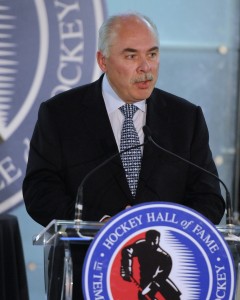The OHL has introduced three new rules to their rule book for the 2016-17 season and one has people talking.
The three new rules include the “Blindside Hit” Rule, the Hybrid Icing and the “Three-Fight” Rule. The Blindside Hit Rule is where a player is penalized for hitting a player from the blindside. It’s up to the discretion of the officials whether the penalty warrants a minor, double minor or a major, which may lead to further punishment from the league. Hybrid Icing is the ability for officials to call an icing on a play without anyone touching the puck behind the goal line if the defender is between the attacker and the puck. If the attacker is still skating to get the puck, the linesmen must use their discretion. Both of those rules make perfect sense and will help with the flow and safety of a game. The rule that has everyone talking, though, is the Three-Fight rule.

As of the start of the 2016-17 season, no player shall have more than three fights in a season and any fights beyond that will result in a suspension. This does not include fights in which a player is instigated upon, as only the instigator will have the fight count against them.
The league is clearly trying to get rid of head shots and, with the significant increase in concussions and head injuries that have come to the light over the last few seasons, that’s no surprise. Is dropping from 10 fights to three in a season truly the best way to do this?
Changing Way Game Is Played
By going from 10 to three, the OHL has essentially removed the ability of a player to create a physical game and removed the ability to stand up for his teammate should it be needed. Too many times a player will lay a big hit in open ice, see a player skating towards him for revenge and they drop the mitts with each receiving five minutes for fighting. Now a player has to look around to see if a hit is going to be met with retribution. One hit leading to one fight is one-third of an allocation for an entire season.
There is also the issue with agitation. Players trash talk all the time and a player could silence them pretty quick with a fight. That can’t happen now, which opens the door for pests to create havoc without consequence.
Reducing the number of fights originally made sense in that it reduces the number of potential injuries down the road. However, at what point does it become too much? There was plenty of debate when the OHL went from unlimited fighting allowance to a “10-Fight” rule prior to the 2012-13 season. Before that rule was implemented, multiple players would drop the gloves 30-or-more times in a season for a variety of reasons. Even fights like this weren’t uncommon:
https://youtu.be/SQDCjCMx-34
By allowing 10 fights before incurring a suspension, the league gave a respectable leeway to the pugilistic side of the game. If a player felt the need to drop the gloves, there were no issues until sometime around February or March. Players stuck to the pure skill aspect of the game, while still being able to play their physical game as deemed fit.
It’s all about to change, though. Players pushing around smaller, less engaging opponents will only get a stern talking-to from the other side. If there’s a big hit in open ice or along the boards that deserves punishment, players better hope the officials see it because there’s little that can be done.
OHL Should Look at Other Options
It’s time to ease up on the fighting rules and look at other ways to make the game safe. For example all head shots are subject to in-game review and an automatic ejection if deemed dangerous. What about different equipment? Players in the modern era are bigger, faster and dedicate their off ice life to physical fitness. Creating equipment that protects both the players wearing it and the opposition could be greatly beneficial to the sport.
The game is evolving and rules are changing for the betterment of the players and their lives, both now and in the future. Altering the rules on fighting is not a bad thing when done properly. The OHL took a solid first step in reducing the fights to 10-per-season, but this second implementation comes across as unnecessary. Until the NHL gives automatic Game Misconducts for fighting, this is as far as the OHL needs to go with their rules. Fighting has its place in the game and it’s time to see what else can be fixed to make it safer for all.